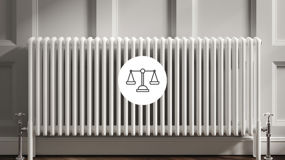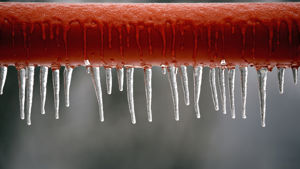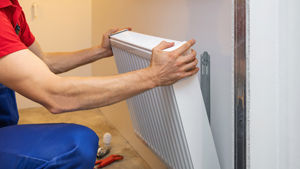If your radiators are unbalanced, they will not heat up at the same speed as each other so it's essential you understand how to balance radiators.
When radiators do not heat up at the same speed, it means some areas of your home will be colder than others, resulting in a non-efficient heating system that can leave you feeling warm in some rooms of the house and cold in others.
What Is Radiator Balancing?
Radiator balancing is the adjustment of your radiator valves to ensure all your radiators heat up at the same speed.
If you find that your individual radiators have cold spots, this could mean trapped air in the system and you'll need to bleed them. If your radiators are cold at the bottom, this could be caused by trapped sludge and you'll need to flush this out.
How can you tell if your radiators are unbalanced?
The main 4 symptoms of an unbalanced radiator include:
- When you switch on your central heating, certain rooms get hotter than others.
- Some rooms could take longer than others to get to the required temperature.
- You see significant variations in room temperatures.
- To get your preferred temperature, you must adjust your thermostat significantly higher or lower.
If you are seeing these signs in your home, you’ll want to balance your radiators to fix this issue, using the correct tools.
How To Balance Radiators
Here we provide a detailed step by step guide on how to balance your radiators. But first, what tools will you need?
Tools You’ll Need to Balance a Radiator:
- Radiator bleed key
- Lockshield valve key
- Screwdriver
- Digital thermometer/multimeter with thermometer
- Adjustable spanner
Step by step guide:
- Turn off your heating
- Open all radiator valves
- Note the speed each radiator heats up
- Allow your heating to cool down
- Turn your heating back on
- Adjust the fastest radiator
- Repeat for other radiators
We'll take you through each step in more detail below!
1. Switch off your heating
To begin balancing radiators, all the radiators and heated towel rails in your home must be completely cold. So, you'll need to switch your heating off and allow radiators to cool completely before starting.
It does also help if you have recently managed to bleed your radiators, as your upcoming temperature readings will be more accurate.

2. Open up all your radiator valves
Once your radiators are cold, you then need to open all the radiator valves in your home by turning them anti-clockwise. Thermostatic valves and wheelhead valves can be opened easily by turning them by hand.
Lockshield valves will have a plastic cover which will need to be removed. You can then use your adjustable spanner or lockshield valve key to turn the valve anti-clockwise and open it.

3. Note the speed each radiator heats up
With all your radiator valves open, it’s time to turn on your heating and make a note of the speed at which each of your radiators heat up.
It helps to enlist a few friends or the kids at this point so that you can keep an eye on how fast all the radiators warm up. You'll usually find those radiators nearest the boiler will be faster.

4. Allow your heating to cool down
Once again you'll need to turn everything off and allow your heating system to cool down. Letting your system completely cool down may take a while and some people will prefer to leave it overnight, which is why it's a good idea to do this before it gets too cold!
5. Turn your heating back on
Once you've let your radiators cool down completely, you'll need to turn your heating back on and head to the radiator which has warmed up the fastest.
6. Adjust the fastest radiator
You'll need to adjust the fastest radiator in your home first. Close the lockshield valve on this radiator completely, then open it by one quarter turn.
Once it's started to heat up you'll need to take some measurements with your digital thermometer or multimeter with thermometer.
First measure the temperature of the pipework next to the valve. Then, take the temperature of the pipework on the opposite side of the radiator, usually where the TRV is. Make sure you take a note of both of these readings.
You'll now need to turn the lockshield valve very gradually until the difference between the readings of the two pipes is 12°c precisely.
It's important to remember balancing radiators takes time. You'll need to wait for the temperature of the radiator to change each time you adjust the lockshield before you can get an accurate measurement.

7. Repeat for other radiators
Now that you've balanced your first radiator to an exact difference of 12°c, it's time to tend to your slightly slower radiators and balance them just the same. Do this in the order they took to heat up.
What you'll find when balancing radiators is that the amount the lockshield valve needs to be opened is correlative to the distance of the radiator from your home’s boiler. When it comes to the slowest of your radiators, you may find the lockshield valve even needs to be opened completely.
If you followed the above steps correctly, you'll find your radiators are now balanced. The dispersal of hot water from your boiler is reaching the furthest radiator from your boiler as evenly as it is reaching the closest.
Balancing Radiators FAQS
Got some unanswered questions about the process of balancing radiators? These commonly asked questions and answers should help.
1. Balancing Radiators - Why 12 Degrees?
The ideal temperature for a balanced radiator is 12 degrees because it is the most energy efficient temperature to heat a room without overdoing it. At 12 degrees, the room will be warm enough to be comfortable, but not so warm that it is wasting energy.
2. What Does a Lockshield Valve do?
A lockshield valve is a small, adjustable valve used to balance the flow of hot water through a radiator or other device. It is used to adjust the flow of water to each radiator or device, so that each one receives the same amount of heat. This helps to ensure that each radiator or device is heating up evenly, giving you the most efficient heating system possible.
3. How To Balance Radiators Without a Thermometer
Start by turning the valve a quarter turn on the first radiator on your list. The last radiator on your list's valve can then be fully opened. Depending on their placement on your list, the various radiator valves will need to be opened to varying degrees. As an example, the first radiator should be opened 25%, the second 30%, the third 40%, and so on until the last radiator is opened 100%. Try to distribute the opening percentages evenly across your property, taking into account the number of radiators you have.
If you are still unsure about the way to go about this properly, we would always recommend asking for help either from a friend who knows about it or your trusted plumber!








